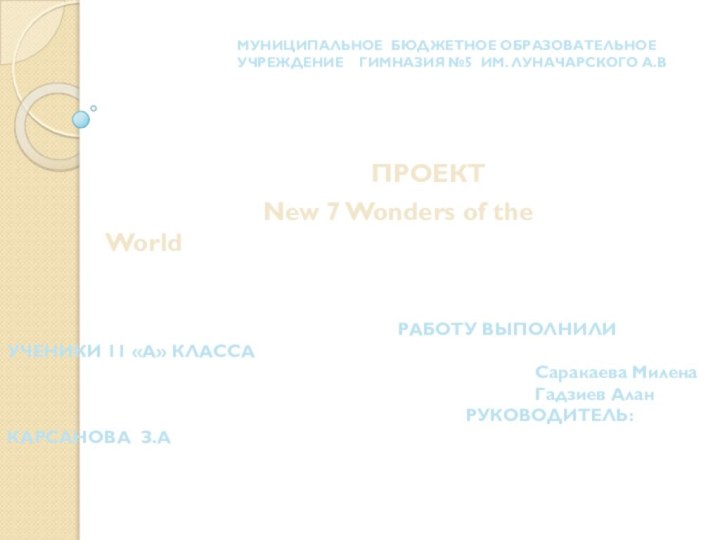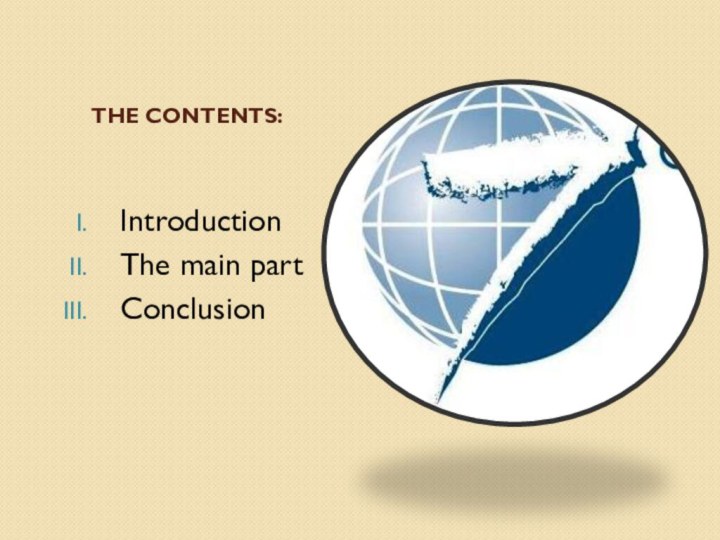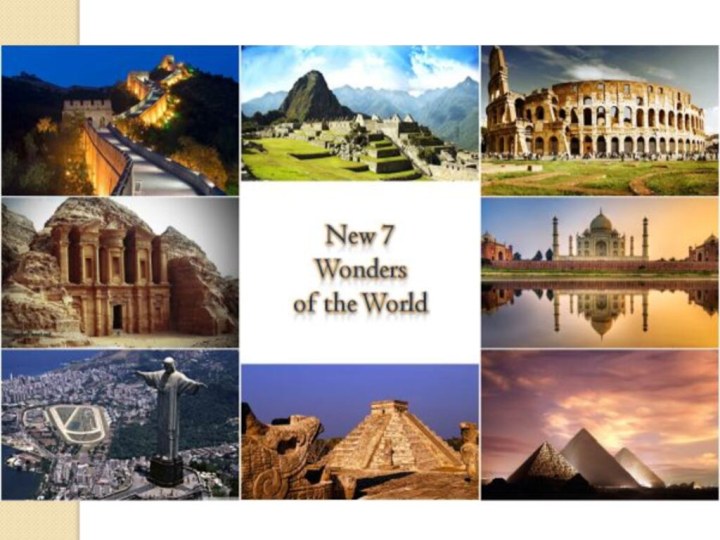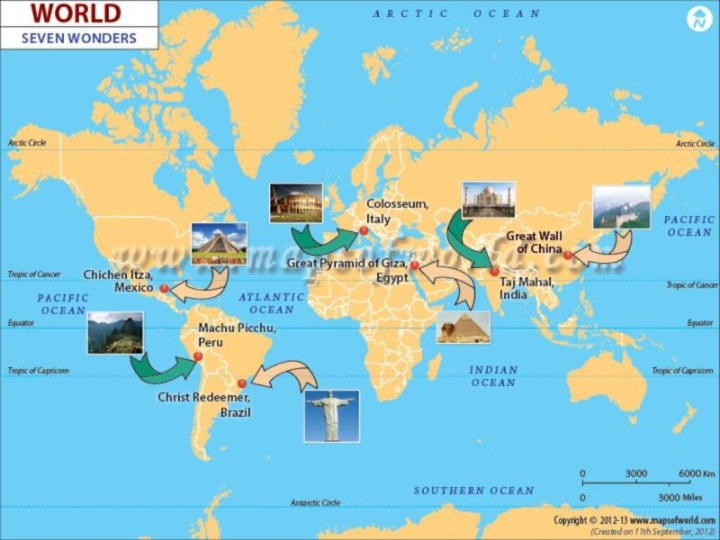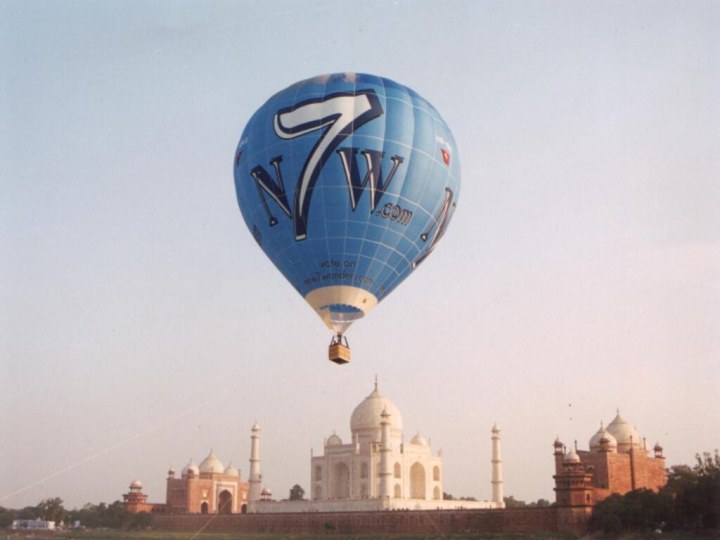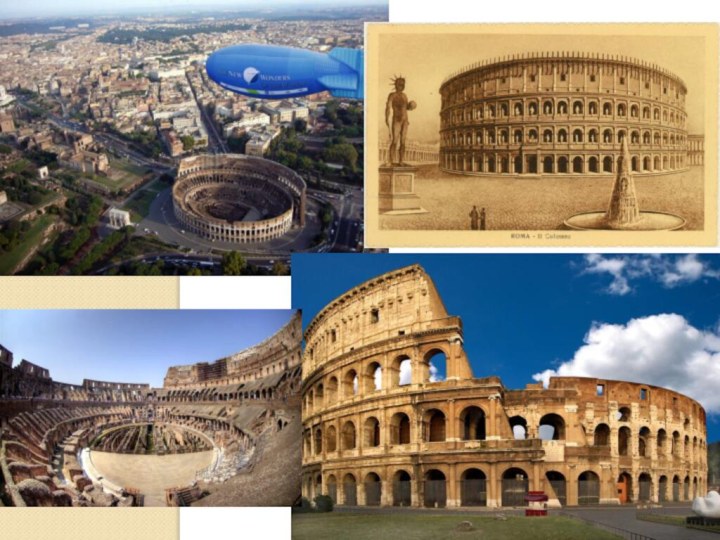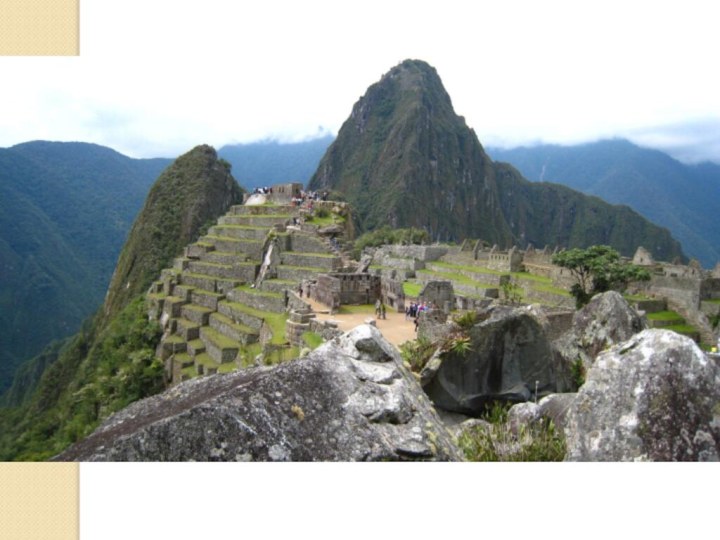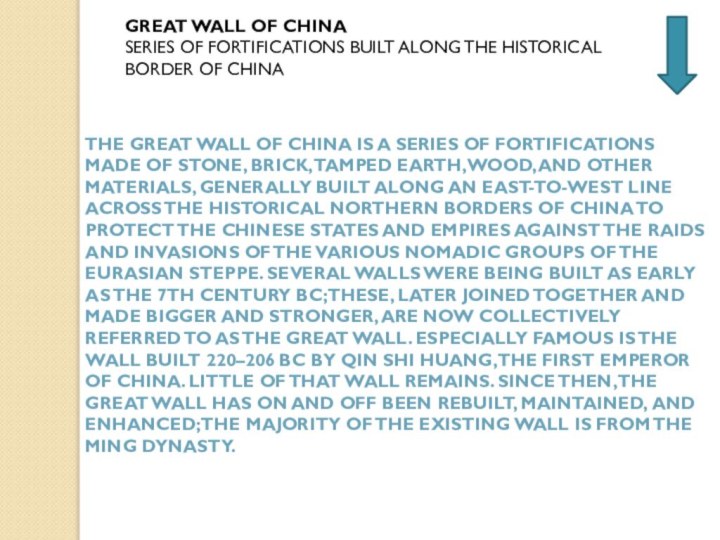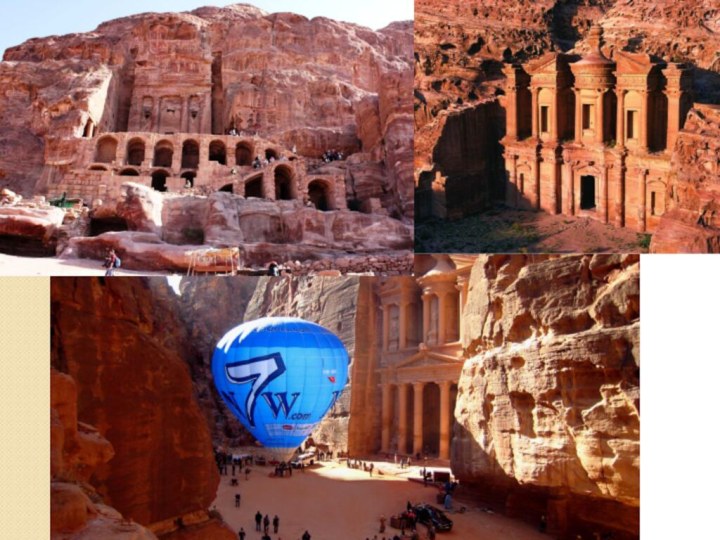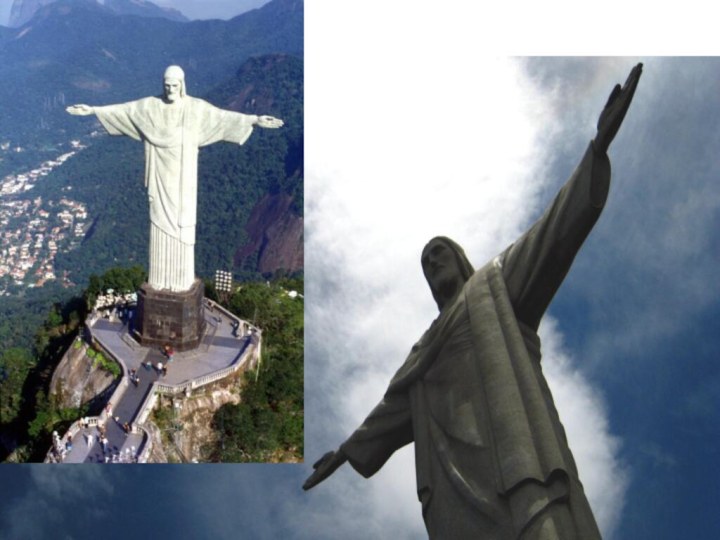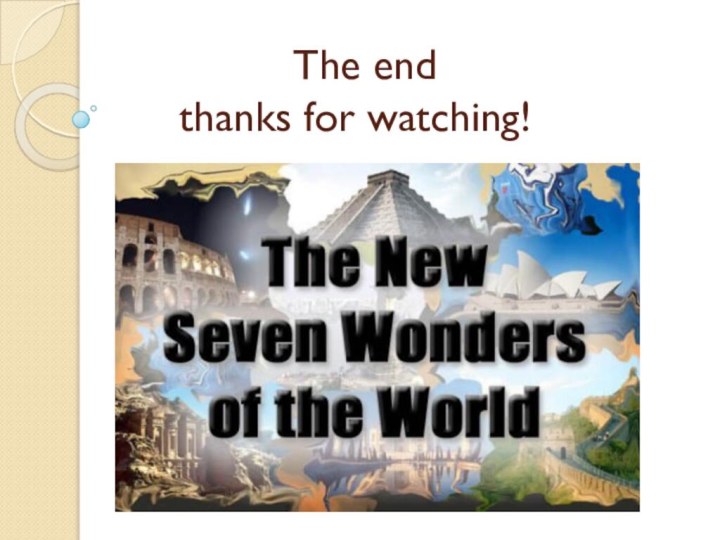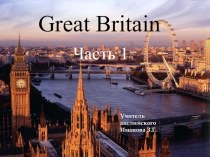Слайд 2
THE CONTENTS:
Introduction
The main part
Conclusion
Слайд 4
New 7 Wonders of the World (2000–2007) was an
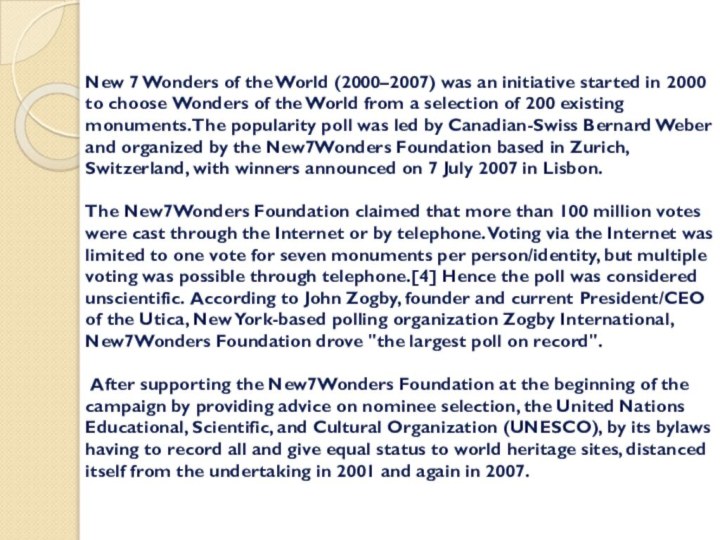
initiative started in 2000 to choose Wonders of the World from
a selection of 200 existing monuments. The popularity poll was led by Canadian-Swiss Bernard Weber and organized by the New7Wonders Foundation based in Zurich, Switzerland, with winners announced on 7 July 2007 in Lisbon.
The New7Wonders Foundation claimed that more than 100 million votes were cast through the Internet or by telephone. Voting via the Internet was limited to one vote for seven monuments per person/identity, but multiple voting was possible through telephone.[4] Hence the poll was considered unscientific. According to John Zogby, founder and current President/CEO of the Utica, New York-based polling organization Zogby International, New7Wonders Foundation drove "the largest poll on record".
After supporting the New7Wonders Foundation at the beginning of the campaign by providing advice on nominee selection, the United Nations Educational, Scientific, and Cultural Organization (UNESCO), by its bylaws having to record all and give equal status to world heritage sites, distanced itself from the undertaking in 2001 and again in 2007.
Слайд 5
From left to right, top to bottom: Chichen Itza, Christ
the Redeemer, Great Wall of China, Machu Picchu, Petra, Taj Mahal, and Colosseum.
Слайд 7
TAJ MAHAL
Agra & Uttar Pradesh, India
The Taj Mahal is
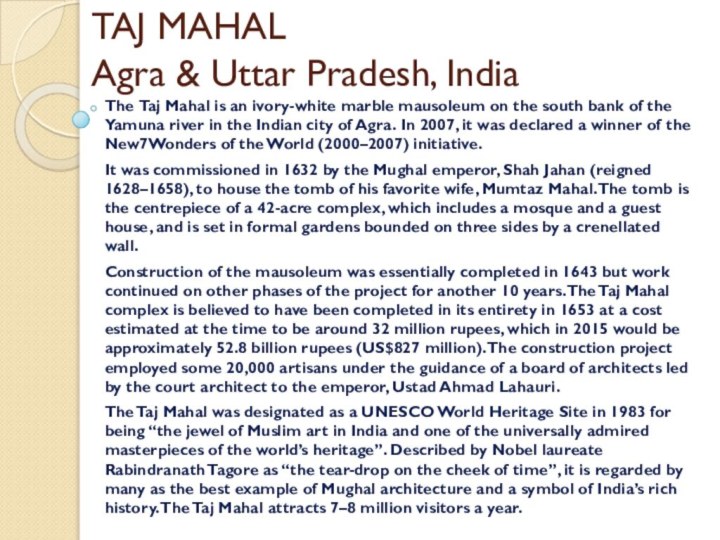
an ivory-white marble mausoleum on the south bank of
the Yamuna river in the Indian city of Agra. In 2007, it was declared a winner of the New7Wonders of the World (2000–2007) initiative.
It was commissioned in 1632 by the Mughal emperor, Shah Jahan (reigned 1628–1658), to house the tomb of his favorite wife, Mumtaz Mahal. The tomb is the centrepiece of a 42-acre complex, which includes a mosque and a guest house, and is set in formal gardens bounded on three sides by a crenellated wall.
Construction of the mausoleum was essentially completed in 1643 but work continued on other phases of the project for another 10 years. The Taj Mahal complex is believed to have been completed in its entirety in 1653 at a cost estimated at the time to be around 32 million rupees, which in 2015 would be approximately 52.8 billion rupees (US$827 million). The construction project employed some 20,000 artisans under the guidance of a board of architects led by the court architect to the emperor, Ustad Ahmad Lahauri.
The Taj Mahal was designated as a UNESCO World Heritage Site in 1983 for being “the jewel of Muslim art in India and one of the universally admired masterpieces of the world’s heritage”. Described by Nobel laureate Rabindranath Tagore as “the tear-drop on the cheek of time”, it is regarded by many as the best example of Mughal architecture and a symbol of India’s rich history. The Taj Mahal attracts 7–8 million visitors a year.
Слайд 9
COLOSSEUM
Rome, Italy
The Colosseum or Coliseum is an oval amphitheatre in the centre

of the city of Rome, Italy. Built of concrete
and sand, it is the largest amphitheatre ever built. The Colosseum is situated just east of the Roman Forum. Construction began under the emperor Vespasian in AD 72, and was completed in AD 80 under his successor and heir Titus. Further modifications were made during the reign of Domitian (81–96). These three emperors are known as the Flavian dynasty, and the amphitheatre was named in Latin for its association with their family name (Flavius).
The Colosseum could hold, it is estimated, between 50,000 and 80,000 spectators, having an average audience of some 65,000; it was used for gladiatorial contests and public spectacles such as mock sea battles (for only a short time as the hypogeum was soon filled in with mechanisms to support the other activities), animal hunts, executions, re-enactments of famous battles, and dramas based on Classical mythology. The building ceased to be used for entertainment in the early medieval era. It was later reused for such purposes as housing, workshops, quarters for a religious order, a fortress, a quarry, and a Christian shrine.
Although partially ruined because of damage caused by earthquakes and stone-robbers, the Colosseum is still an iconic symbol of Imperial Rome. It is one of Rome’s most popular tourist attractions and has also links to the Roman Catholic Church, as each Good Friday the Pope leads a torchlit “Way of the Cross” procession that starts in the area around the Colosseum.
Слайд 11
MACHU PICCHU
15TH-CENTURY INCA SITE IN PERU
Machu Picchu is a
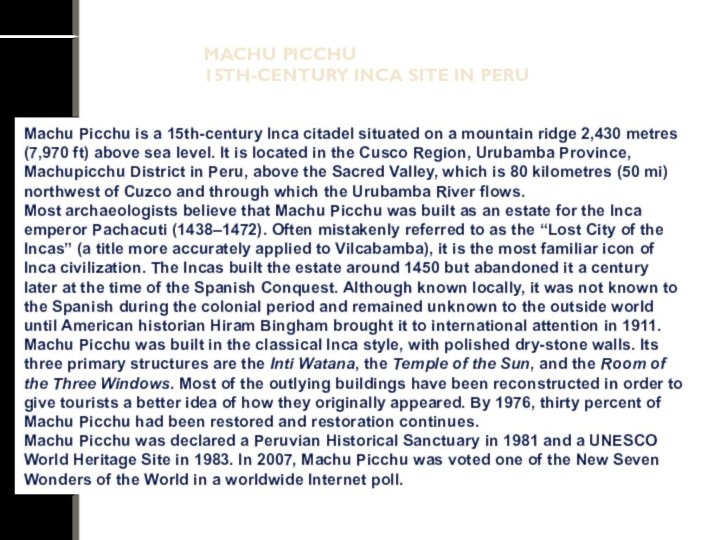
15th-century Inca citadel situated on a mountain ridge 2,430
metres (7,970 ft) above sea level. It is located in the Cusco Region, Urubamba Province, Machupicchu District in Peru, above the Sacred Valley, which is 80 kilometres (50 mi) northwest of Cuzco and through which the Urubamba River flows.
Most archaeologists believe that Machu Picchu was built as an estate for the Inca emperor Pachacuti (1438–1472). Often mistakenly referred to as the “Lost City of the Incas” (a title more accurately applied to Vilcabamba), it is the most familiar icon of Inca civilization. The Incas built the estate around 1450 but abandoned it a century later at the time of the Spanish Conquest. Although known locally, it was not known to the Spanish during the colonial period and remained unknown to the outside world until American historian Hiram Bingham brought it to international attention in 1911.
Machu Picchu was built in the classical Inca style, with polished dry-stone walls. Its three primary structures are the Inti Watana, the Temple of the Sun, and the Room of the Three Windows. Most of the outlying buildings have been reconstructed in order to give tourists a better idea of how they originally appeared. By 1976, thirty percent of Machu Picchu had been restored and restoration continues.
Machu Picchu was declared a Peruvian Historical Sanctuary in 1981 and a UNESCO World Heritage Site in 1983. In 2007, Machu Picchu was voted one of the New Seven Wonders of the World in a worldwide Internet poll.
Слайд 13
CHICHÉN ITZÁ
Mexico
El Castillo , is a Mesoamerican step-pyramid that
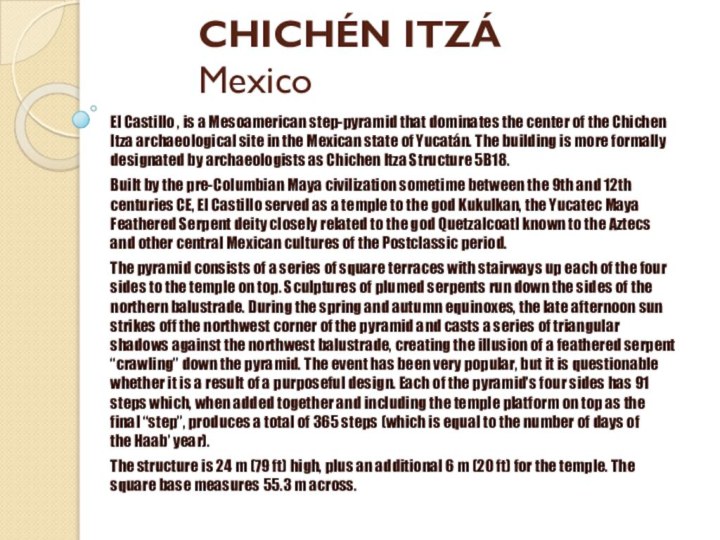
dominates the center of the Chichen Itza archaeological site
in the Mexican state of Yucatán. The building is more formally designated by archaeologists as Chichen Itza Structure 5B18.
Built by the pre-Columbian Maya civilization sometime between the 9th and 12th centuries CE, El Castillo served as a temple to the god Kukulkan, the Yucatec Maya Feathered Serpent deity closely related to the god Quetzalcoatl known to the Aztecs and other central Mexican cultures of the Postclassic period.
The pyramid consists of a series of square terraces with stairways up each of the four sides to the temple on top. Sculptures of plumed serpents run down the sides of the northern balustrade. During the spring and autumn equinoxes, the late afternoon sun strikes off the northwest corner of the pyramid and casts a series of triangular shadows against the northwest balustrade, creating the illusion of a feathered serpent “crawling” down the pyramid. The event has been very popular, but it is questionable whether it is a result of a purposeful design. Each of the pyramid’s four sides has 91 steps which, when added together and including the temple platform on top as the final “step”, produces a total of 365 steps (which is equal to the number of days of the Haab’ year).
The structure is 24 m (79 ft) high, plus an additional 6 m (20 ft) for the temple. The square base measures 55.3 m across.
Слайд 15
GREAT WALL OF CHINA
SERIES OF FORTIFICATIONS BUILT ALONG
THE HISTORICAL BORDER OF CHINA
The Great Wall of China is a
series of fortifications made of stone, brick, tamped earth, wood, and other materials, generally built along an east-to-west line across the historical northern borders of China to protect the Chinese states and empires against the raids and invasions of the various nomadic groups of the Eurasian Steppe. Several walls were being built as early as the 7th century BC; these, later joined together and made bigger and stronger, are now collectively referred to as the Great Wall. Especially famous is the wall built 220–206 BC by Qin Shi Huang, the first Emperor of China. Little of that wall remains. Since then, the Great Wall has on and off been rebuilt, maintained, and enhanced; the majority of the existing wall is from the Ming Dynasty.

PETRA
Ma'an Governorate, Jordan
Petra is a historical and
archaeological city in southern Jordan. The city is famous for its rock-cut architecture and water conduit system. Another name for Petra is the Rose City due to the color of the stone out of which it is carved.
Established possibly as early as 312 BC as the capital city of the Arab Nabataeans, it is a symbol of Jordan, as well as Jordan’s most-visited tourist attraction. The Nabateans were nomadic Arabs who benefited from the proximity of Petra to the regional trade routes, in becoming a major trading hub, thus enabling them to gather wealth. The Nabateans are also known for their great ability in constructing efficient water collecting methods in the barren deserts and their talent in carving structures into solid rocks. It lies on the slope of Jebel al-Madhbah (identified by some as the biblical Mount Hor) in a basin among the mountains which form the eastern flank of Arabah (Wadi Araba), the large valley running from the Dead Sea to the Gulf of Aqaba. Petra has been a UNESCO World Heritage Site since 1985.
Слайд 19
CHRIST THE REDEEMER
STATUE OF JESUS IN RÍO DE
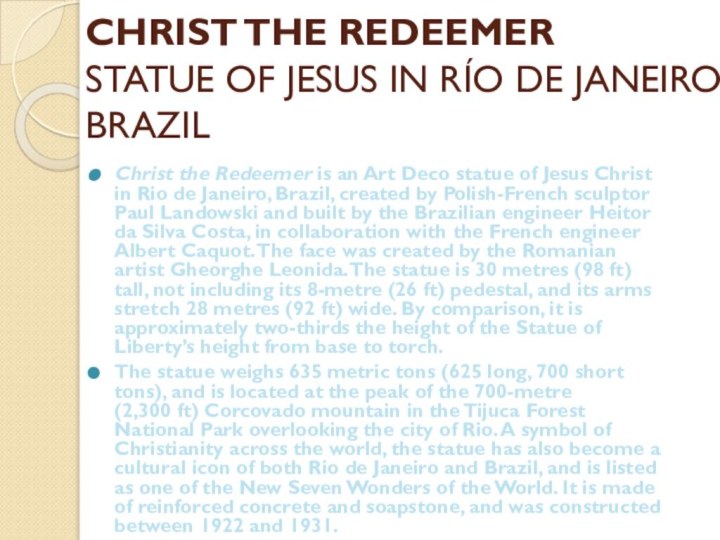
JANEIRO, BRAZIL
Christ the Redeemer is an Art Deco statue
of Jesus Christ in Rio de Janeiro, Brazil, created by Polish-French sculptor Paul Landowski and built by the Brazilian engineer Heitor da Silva Costa, in collaboration with the French engineer Albert Caquot. The face was created by the Romanian artist Gheorghe Leonida. The statue is 30 metres (98 ft) tall, not including its 8-metre (26 ft) pedestal, and its arms stretch 28 metres (92 ft) wide. By comparison, it is approximately two-thirds the height of the Statue of Liberty’s height from base to torch.
The statue weighs 635 metric tons (625 long, 700 short tons), and is located at the peak of the 700-metre (2,300 ft) Corcovado mountain in the Tijuca Forest National Park overlooking the city of Rio. A symbol of Christianity across the world, the statue has also become a cultural icon of both Rio de Janeiro and Brazil, and is listed as one of the New Seven Wonders of the World. It is made of reinforced concrete and soapstone, and was constructed between 1922 and 1931.
Слайд 21
The New 7 Wonders Foundation, established in 2001,
relied on private donations and the sale of broadcast
rights and received no public funding or taxpayers' money. After the final announcement, New7Wonders said it didn't earn anything from the exercise and barely recovered its investment.
Although N7W describes itself as a not-for-profit organization, the company behind it—the New Open World Corporation (NOWC)—is a commercial business. All licensing and sponsorship money is paid to NOWC.
The foundation has run two subsequent programs: New7Wonders of Nature, the subject of voting until 2011, and New7WondersCities, which wound up in 2014.
The end
thanks for watching!
